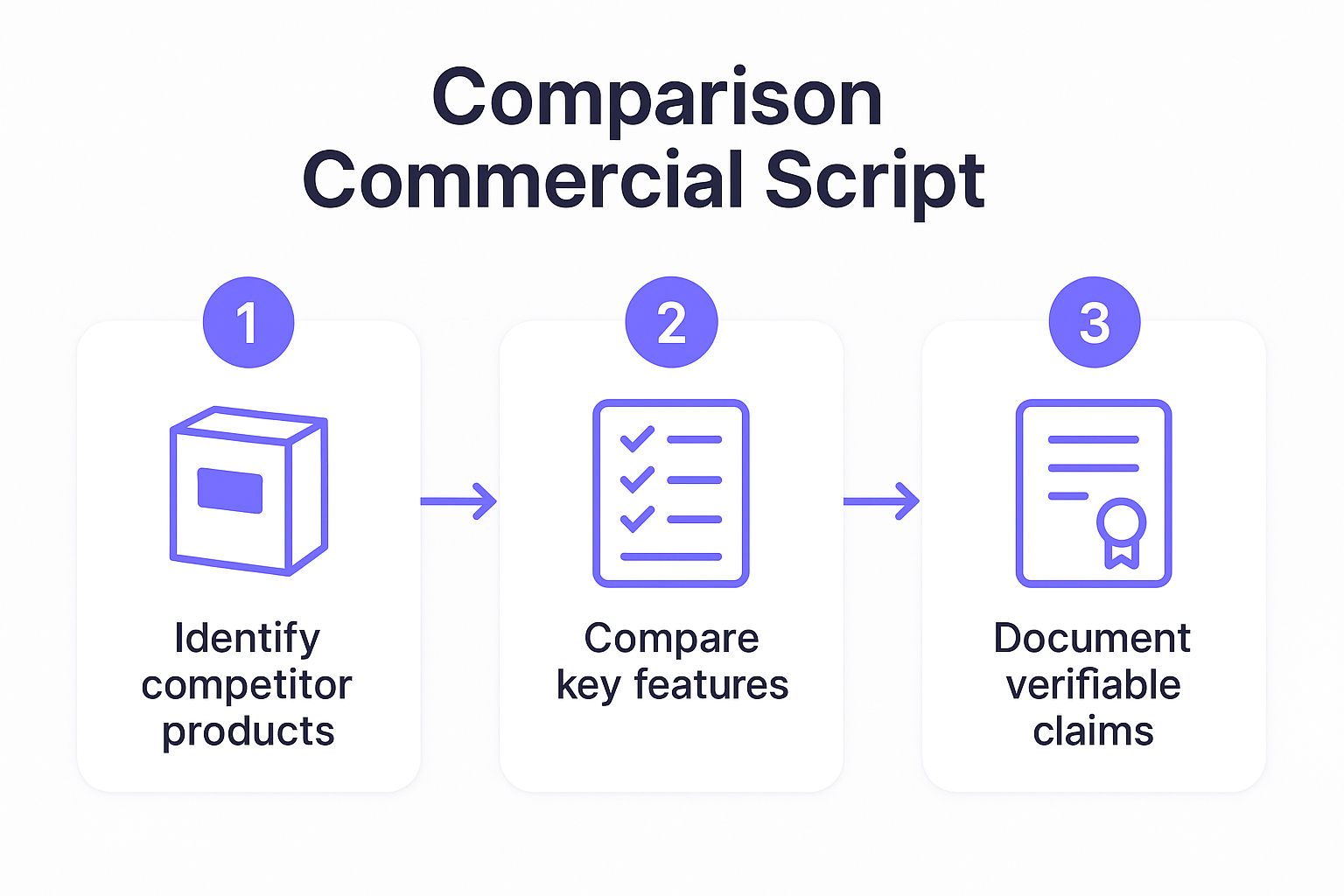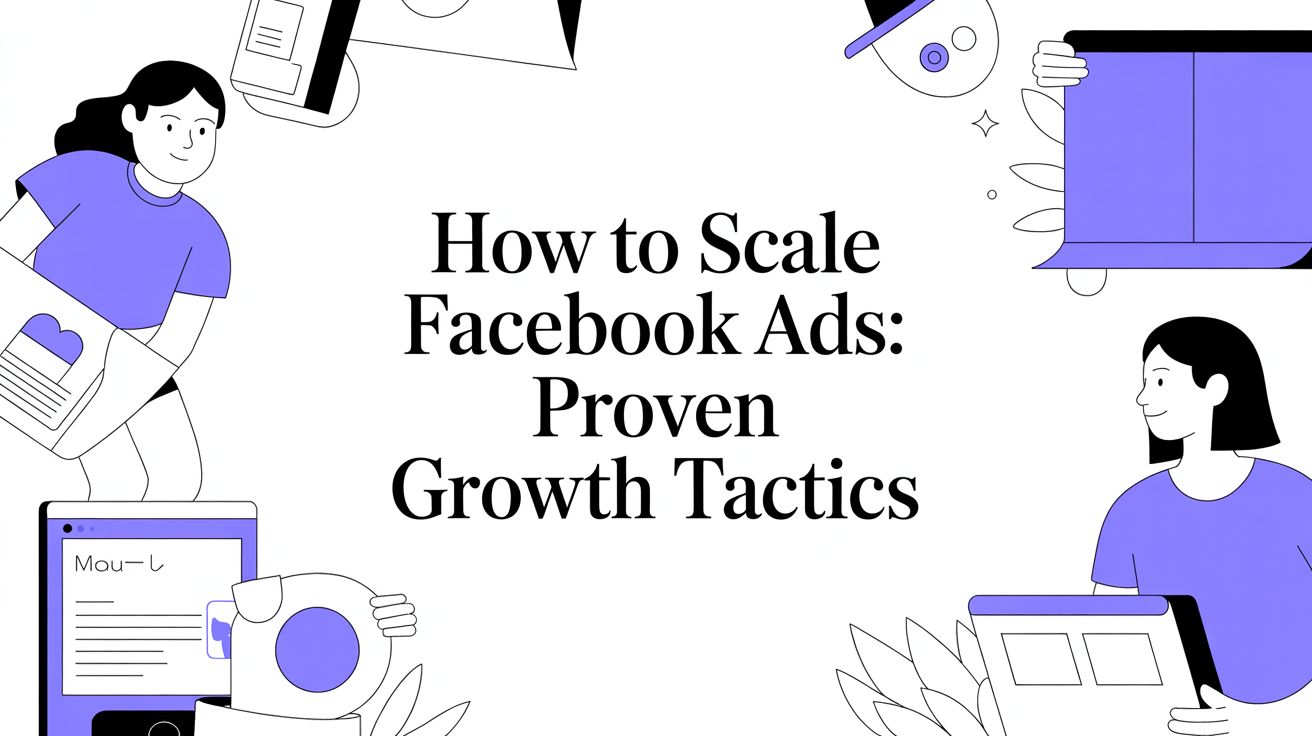A great commercial starts long before the cameras roll; it begins with a powerful script. A well-crafted script is the blueprint for persuasion, capable of capturing attention, evoking emotion, and driving action in 30 seconds or less. But how do you move from a simple idea to a compelling narrative that resonates with modern audiences? It’s not just about what you say, but how you structure your message.
In this guide, we move beyond theory and dive into a deep analysis of proven commercial script examples. We will dissect precisely what makes them effective, from the psychological triggers they pull to the specific narrative frameworks they employ. You will gain actionable insights and replicable strategies to craft your own high-performing ads.
This article isn't just a list; it’s a strategic breakdown of effective advertising. We'll explore the DNA of successful ads across different styles, including problem-solution, emotional storytelling, and humor. Whether you're a startup founder or a seasoned marketer, understanding these frameworks is the first step toward transforming your creative vision into tangible results. You'll leave with the tools to write with clarity, confidence, and purpose.
1. Problem-Solution Commercial Script
The Problem-Solution format is a cornerstone of advertising and one of the most effective commercial script examples for a simple reason: it mirrors our natural decision-making process. This classic script structure first presents a relatable, often frustrating, problem that the target audience experiences. It agitates that pain point to create an emotional connection, then introduces the product or service as the perfect, satisfying solution.

This direct approach, famously used by brands like OxiClean and Head & Shoulders, works by creating a clear narrative of relief and resolution. The formula is simple: Problem (a tough stain, dandruff) leads to Agitation (frustration, embarrassment), which is resolved by the Solution (the product), resulting in a positive Outcome (clean clothes, confidence).
Strategic Breakdown
The power of this script lies in its psychological framing. By leading with the problem, you immediately capture the attention of anyone who has faced a similar issue. The brand then becomes a hero, swooping in to save the day. This structure is especially potent for products that solve a very specific, tangible problem.
For instance, home security ads don't just sell cameras; they sell peace of mind by first highlighting the fear of a break-in. This emotional journey from anxiety to security makes the product's value proposition crystal clear and highly memorable.
Actionable Takeaways
To effectively use the Problem-Solution script format, focus on these key tactics:
- Focus on a Single, Clear Problem: Don't try to solve everything at once. Pick one primary pain point and dedicate the entire script to solving it.
- Show, Don't Just Tell: Visually demonstrate the problem and the solution in action. A side-by-side comparison or a dramatic before-and-after shot is incredibly effective.
- Use Relatable Language: Use the same words and phrases your customers use to describe their problems. This builds authenticity and trust.
This scripting method is ideal for direct response marketing, where the goal is to drive an immediate purchase. By presenting a clear problem and an easy solution, you simplify the buyer's journey. For those interested in modernizing this approach, you can learn more about how to create AI video ads that follow this proven structure.
2. Testimonial-Based Commercial Script
The Testimonial-Based commercial script leverages the power of social proof by putting authentic customer stories front and center. Instead of the brand telling you how great its product is, satisfied users do the talking. This format builds immediate trust and credibility by showcasing real-world results and genuine experiences, making it one of the most persuasive commercial script examples.

This approach is famously used by brands like Weight Watchers and the B2B software industry. It works by transforming a customer's success story into a compelling narrative. The structure is built on Authenticity (a real person, not an actor) sharing their specific Challenge (losing weight, streamlining workflow), the Product's Role (how it helped), and the tangible Result (pounds lost, hours saved). This creates a powerful peer-to-peer recommendation.
Strategic Breakdown
The strength of a testimonial script lies in its ability to overcome viewer skepticism. An authentic story from someone the audience can relate to feels less like an advertisement and more like genuine advice. The focus shifts from the brand's claims to the user's verified outcome, making the benefits feel more achievable and believable.
For example, a medical device ad featuring a real patient describing how the product improved their quality of life is far more impactful than a simple list of features. This emotional connection, rooted in a true story, helps the audience envision their own potential success with the product, effectively turning a satisfied customer into the brand’s most convincing salesperson.
Actionable Takeaways
To create an effective Testimonial-Based script, focus on these essential tactics:
- Prioritize Authenticity: Use real customers whenever possible. Their unscripted honesty and genuine emotion are difficult to replicate and resonate deeply with viewers.
- Showcase Specific, Measurable Results: Vague praise is forgettable. A testimonial that states, "I lost 30 pounds in four months," or "We reduced our processing time by 50%," provides concrete proof of value.
- Keep the Story Concise and Focused: Edit the testimonial to highlight the most compelling parts of the customer's journey. Focus on the core challenge and the ultimate positive transformation.
This script format is especially powerful for products or services where trust is a major factor in the purchasing decision. By amplifying customer voices, you are essentially creating modern, scalable user-generated content ads that build a community around your brand.
3. Demonstration Commercial Script
The Demonstration commercial script is built on the simple yet powerful principle of "show, don't tell." Instead of just talking about what a product can do, this format proves its value by showing it in action. It’s one of the most persuasive commercial script examples because it provides tangible, visual evidence of a product's effectiveness and superiority.
This approach bypasses abstract claims and gets straight to the point, letting the product become the star of the show. It’s about building trust through transparency and proof, making it a go-to strategy for brands with innovative features or clear performance advantages.
Legendary examples range from the classic ShamWow infomercials showing incredible absorbency to Apple’s sleek product launches that walk through new features with elegant visuals. The core formula is straightforward: Introduce Feature (a powerful blender blade), Demonstrate Functionality (it pulverizes an iPhone), which highlights the Key Benefit (unmatched power and durability), leading to a compelling Proof of Value.
Strategic Breakdown
The power of the demonstration script comes from its ability to cut through viewer skepticism. In a market full of exaggerated claims, seeing is believing. This format makes a product’s benefits undeniable by visually validating its promises right before the audience's eyes.
This strategy is exceptionally effective for products whose value is tied to performance, functionality, or a unique physical attribute. Kitchen appliance ads that show a blender crushing ice effortlessly or automotive ads demonstrating superior handling on a difficult road use this script to make their value proposition tangible and memorable. The visual proof creates a direct and powerful connection between the feature and its real-world benefit.
Actionable Takeaways
To create a compelling Demonstration commercial script, concentrate on these proven tactics:
- Isolate a "Wow" Factor: Don't try to show every single feature. Focus on the one or two most impressive functions that will make your audience say "wow."
- Use Clear Before-and-After Shots: For cleaning products, tools, or software, a side-by-side comparison is the clearest way to demonstrate impact and value.
- Keep the Demo Simple and Clean: The demonstration itself should be easy to understand. Avoid overly complex setups or jargon that could confuse the viewer and dilute the message.
This scripting style is perfect for product launches, e-commerce product pages, and any campaign where tangible proof is your strongest asset. To dive deeper into this visual-first strategy, you can find helpful resources on how to create product demo videos automatically and streamline your production.
4. Emotional Storytelling Commercial Script
The Emotional Storytelling format moves beyond direct selling to create a powerful, lasting connection with the audience. These narrative-driven commercial script examples focus on universal human experiences, relationships, and poignant life moments. The goal isn't to highlight product features but to align the brand with deeply felt emotions, making it part of the viewer's own story.
This sophisticated approach, masterfully used by brands like Google in their search stories and John Lewis in their famous Christmas ads, prioritizes feeling over function. The script builds a compelling narrative arc with characters and a plot, often culminating in an emotional peak. The brand or product is then revealed, not as the hero, but as a quiet enabler of that meaningful moment. The formula is: Relatable Setup (introducing characters and context) leads to an Emotional Journey (building connection and tension), which culminates in a Climactic Resolution, where the Brand is Subtly Integrated.
Strategic Breakdown
The power of this script lies in its ability to bypass rational thought and speak directly to the heart. By telling a story, a brand can communicate its core values and mission without a single sales-oriented word. Viewers remember the feeling the ad gave them and associate that positive emotion with the brand, fostering loyalty that transcends price or features.
For example, the iconic Always '#LikeAGirl' campaign didn't sell sanitary pads; it sold empowerment. By telling a story about societal perceptions and challenging a common insult, the brand became a champion for female confidence. This emotional resonance transformed a simple product into a symbol of strength, creating a cultural moment and immense brand affinity.
Actionable Takeaways
To effectively use the Emotional Storytelling script format, focus on these key tactics:
- Align the Story with Brand Values: The narrative must be an authentic reflection of what your brand stands for. A story about community connection wouldn't fit a brand built on fierce individualism.
- Focus on Universal Emotions: Center your script on emotions that everyone can understand, like love, loss, joy, or triumph. This ensures the widest possible connection with your audience.
- Keep Product Integration Subtle: The product should be a natural part of the story, not the focus. It might be the tool that connects two people or the gift that sparks a special moment, but the story must come first.
This scripting method is ideal for brand-building campaigns where the goal is long-term customer loyalty and positive brand perception. By creating an emotional anchor, you make your brand unforgettable.
5. Comparison Commercial Script
The Comparison Commercial Script is a bold and direct advertising strategy that works by placing a product or service side-by-side with its competition. This approach aims to highlight a brand's superior features, better value, or more effective performance. It leverages a viewer's desire to make the smartest choice by providing a clear, often data-driven, reason to choose one brand over another.
This technique was famously and effectively used in the iconic "Mac vs. PC" campaign and the "Pepsi Challenge." The script's core logic is simple: Identify Competitor (the established or rival brand), Highlight Differentiator (a key feature, price, or result), and Establish Superiority (positioning the advertised brand as the obvious winner), leading to a Confident Purchase Decision for the consumer. This is one of the most persuasive commercial script examples when executed correctly.
The following infographic outlines the fundamental process for creating a defensible and effective comparison script.

This step-by-step flow emphasizes that a strong comparison ad is built on a foundation of factual, verifiable claims, not just empty boasts.
Strategic Breakdown
The power of a comparison script comes from its ability to reframe the market landscape in the brand's favor. Instead of letting consumers discover differences on their own, the brand controls the narrative, focusing the audience's attention on the specific areas where it excels. This is particularly effective for challenger brands trying to gain market share from a dominant leader or for products with a clear, demonstrable technological or cost advantage.
For example, wireless carriers like Verizon and T-Mobile frequently use this format. They don't just say their network is good; they show coverage maps, present data on download speeds, and compare pricing plans directly against their rivals. This transforms an abstract claim of "better service" into tangible, easy-to-understand proof points, simplifying the consumer's decision-making process.
Actionable Takeaways
To create a compelling Comparison Commercial Script, concentrate on these tactics:
- Focus on Meaningful Differences: Don't compare trivial features. Highlight a point of differentiation that genuinely matters to your target audience, such as significant cost savings, superior performance, or an exclusive feature.
- Ensure All Claims Are Verifiable: This is the most critical rule. Any direct comparison must be backed by solid data, third-party testing, or clear evidence. False or misleading claims can lead to legal trouble and a loss of consumer trust.
- Maintain a Respectful Tone: You can be competitive without being disrespectful or overly aggressive. The goal is to elevate your brand, not just tear down another. A confident, fact-based tone is more persuasive than a disparaging one.
6. Celebrity Endorsement Commercial Script
The Celebrity Endorsement commercial script is a powerhouse of advertising that leverages the fame, credibility, and charisma of a well-known person to promote a product or service. This strategy operates on a simple principle of association: by placing a beloved celebrity alongside a brand, the positive feelings and trust the audience has for that star are transferred to the product itself.
This approach is one of the most classic and enduring commercial script examples because it provides an instant marketing shortcut. Brands like Nike with Michael Jordan or Lincoln with Matthew McConaughey have used this to perfection. The script doesn't just sell a product; it sells an aspirational lifestyle or a sense of quality vouched for by a trusted public figure. The formula is straightforward: Celebrity (a respected figure) + Product (the item being sold) = Transferred Trust (audience associates the celebrity's positive attributes with the brand), leading to Increased Sales and Brand Equity.
Strategic Breakdown
The core strength of a celebrity-led script is its ability to cut through the noise and immediately capture attention. A familiar face creates an instant connection, making the audience more receptive to the message. The celebrity acts as a credible "super-user," whose endorsement implies the product is of high quality and worth purchasing.
For example, when Jennifer Aniston appears in a Smartwater ad, the script doesn't need to work hard to explain the product's benefits. Her presence alone conveys a sense of health, wellness, and effortless sophistication. The script can then focus on reinforcing that image, using the celebrity's persona as the main vehicle for the brand’s message. This makes the brand feel more established and trustworthy.
Actionable Takeaways
To effectively write a Celebrity Endorsement script, consider these key tactics:
- Ensure an Authentic Fit: The celebrity's public persona must align with your brand's values. A mismatch can feel inauthentic and damage both the celebrity's and the brand's reputation.
- Let the Celebrity Be Themselves: Write the script to match the celebrity's natural voice and personality. A stiff, overly corporate script will come across as a forced advertisement rather than a genuine recommendation.
- Focus on a Shared Story: Don't just have the celebrity hold the product and smile. Create a mini-story that connects the celebrity's own life or values to the product's function, making the endorsement more believable.
This scripting method is ideal for brands looking to rapidly build credibility, appeal to a specific demographic that admires the celebrity, or launch a new product with maximum impact. By borrowing star power, you can give your brand an immediate and powerful boost.
7. Humor-Based Commercial Script
Humor is a powerful tool in advertising, making a brand more memorable, likable, and shareable. A humor-based commercial script uses comedy, wit, or absurdity to capture attention and build a positive emotional connection with the audience. Instead of a hard sell, it entertains viewers, weaving the product or brand into the punchline or a running gag.

This approach has created some of the most iconic campaigns in history, from the surreal Old Spice ads to the charming Geico gecko and Progressive's quirky character, Flo. The core principle is simple: Entertain first, Sell second. By making people laugh, the brand becomes associated with positive feelings, making the message stick long after the commercial ends.
Strategic Breakdown
The effectiveness of humor lies in its ability to disarm the viewer. People are naturally resistant to being sold to, but they are open to being entertained. A funny script breaks down this barrier, making the audience more receptive to the brand’s message. This strategy is excellent for building brand awareness and affinity, especially in crowded markets.
Humor-based commercial script examples often work best when the product itself isn't inherently exciting. Insurance, for example, is a dry topic. Geico and Progressive injected personality and humor into the category, differentiating themselves not by policy details but by creating beloved, comedic characters that audiences look forward to seeing. This turns an ad from an interruption into a piece of welcome content.
Actionable Takeaways
To create a successful humor-based script, consider these tactics:
- Know Your Audience's Humor: What's funny to one demographic can be offensive or confusing to another. Test your jokes and concepts with your target audience to ensure they land correctly.
- Keep the Brand Relevant: The humor should not overshadow the product. The best comedic ads, like those from Doritos, tie the joke directly back to the brand, making it an integral part of the narrative.
- Plan for a Campaign, Not Just One Ad: Characters like Flo or the Geico gecko are effective because they are consistent. Building a humorous world or character over time creates a stronger, more lasting brand connection.
7 Commercial Script Types Comparison
| Script Type | Implementation Complexity | Resource Requirements | Expected Outcomes | Ideal Use Cases | Key Advantages |
|---|---|---|---|---|---|
| Problem-Solution Commercial | Low to Moderate | Low to Moderate | Emotional connection, urgency, measurable | Broad industries, direct response ads | Clear problem focus, highly persuasive |
| Testimonial-Based Commercial | Moderate | Low | Builds trust, reduces purchase anxiety | Services, health, B2B | High credibility, relatable social proof |
| Demonstration Commercial | Moderate to High | Moderate | Concrete proof, product confidence | Tech, appliances, automotive | Visual proof, engages visual learners |
| Emotional Storytelling Commercial | High | High | Strong brand loyalty, emotional connection | Brand building, value-driven marketing | Memorable, long-term brand building |
| Comparison Commercial | Moderate to High | Moderate | Clear differentiation, informed decisions | Competitive markets | Direct positioning, factual persuasion |
| Celebrity Endorsement Commercial | High | High | Instant recognition, credibility boost | Mass market, luxury, lifestyle brands | Star power, aspirational brand elevation |
| Humor-Based Commercial | Moderate | Moderate | High engagement, viral potential | Youth, entertainment-oriented brands | Memorable, shareable, positive emotions |
Turning Scripts into High-Performing Video Content
We've deconstructed the DNA of successful advertising by analyzing a wide range of commercial script examples. From the direct efficiency of a problem-solution framework to the engaging power of a humor-based narrative, these structures are more than just templates; they are proven psychological blueprints for connecting with an audience. The core lesson is that a powerful commercial script is built on a strategic foundation, not just clever dialogue.
The most effective scripts are born from a deep understanding of the target audience. They identify a specific pain point, a core desire, or a relatable human experience and use that as the narrative anchor. Whether you are demonstrating a product's unique feature or telling a heartfelt story, your message must be rooted in a genuine customer insight to resonate authentically.
Key Takeaways for Crafting Your Script
As you move from inspiration to execution, keep these fundamental principles at the forefront of your writing process. These are the threads that connect all successful commercial scripts, regardless of their format or industry.
- Structure is Strategy: The seven script types we explored, including testimonial, comparison, and emotional storytelling, are not arbitrary. Each is designed to achieve a specific marketing goal. Choose the structure that aligns directly with your objective, whether it's driving immediate sales, building brand affinity, or educating the market.
- Clarity Over Complexity: A 30-second or 60-second spot leaves no room for confusion. Your script must have a singular focus. What is the one thing you want the viewer to feel, think, or do? Every line of dialogue, every visual cue, and every sound effect must serve that one primary goal.
- Adapt, Don't Just Copy: While these commercial script examples offer a fantastic starting point, the real magic happens when you infuse them with your unique brand voice. Adapt the structure to fit your product's personality and your company's values. This is how you move from a generic ad to a memorable brand statement.
Your Next Steps to a Winning Commercial
Mastering the art of scriptwriting is an invaluable skill that directly impacts your bottom line. A well-crafted script is the most critical element in maximizing your return on ad spend, ensuring your production budget is used effectively, and turning passive viewers into active customers. It’s the first and most important step in the journey from a simple idea to high-performing video content that grows your business.
The journey begins now. Take the frameworks we've analyzed, select the one that best fits your next campaign, and start outlining. Focus on your core message, write with your customer in mind, and remember to read your script aloud to catch awkward phrasing and ensure a natural flow. By applying these strategic principles, you are no longer just writing an ad; you are engineering a powerful tool for connection and conversion.
Feeling inspired but need a creative boost to get started? Sprello can help you brainstorm concepts and generate compelling script drafts in minutes. Use our AI-powered platform to transform your key messages into a structured, effective commercial script, saving you time and ensuring your next campaign starts with a winning foundation.



